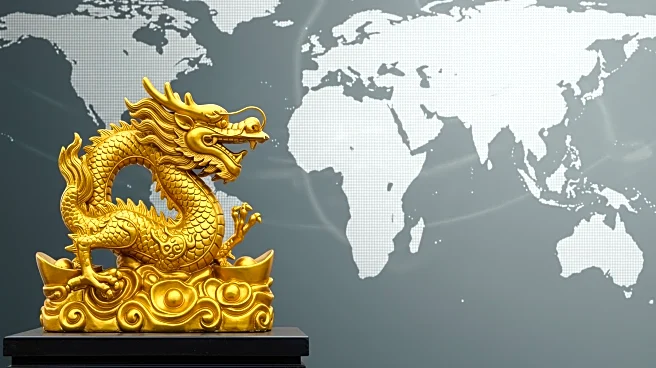What's Happening?
China's economic growth, once seen as unstoppable, is showing signs of stalling. Despite previous predictions of China overtaking the U.S. economy, recent data indicates a slowdown. China's GDP, which had risen to three-quarters of the U.S. economy by 2021, has now fallen back to just over 62% of the U.S. economy. Factors contributing to this slowdown include a declining working-age population, stalled productivity growth, and a challenging external trade environment. The U.S.-China tariff war, which is set to resume after a 90-day pause, further complicates China's economic outlook. Additionally, structural issues such as a downturn in the property sector and weak demand are impacting growth.
Why It's Important?
The slowdown in China's economic growth has significant implications for global trade and economic dynamics. As China struggles with internal and external challenges, its ability to influence global markets may diminish. This shift could impact U.S. industries that rely on Chinese manufacturing and exports. Moreover, the resumption of the U.S.-China tariff war could lead to increased costs for American consumers and businesses. The broader geopolitical landscape may also be affected, as countries reassess their trade relationships with China. The potential decline in China's economic power could alter the balance of global economic influence, benefiting other emerging markets.
What's Next?
The expiration of the 90-day pause in the U.S.-China tariff war is likely to lead to renewed trade tensions. Both countries may need to negotiate new terms to avoid further economic disruption. Additionally, China's government may implement policy measures to stimulate domestic consumption and address structural economic issues. However, these efforts may be hindered by political constraints and weak business confidence. The global community will be watching closely to see how China navigates these challenges and whether it can regain its economic momentum.
Beyond the Headlines
China's economic slowdown raises questions about the sustainability of its growth model, which has relied heavily on high investment and savings rates. The country's political and economic contradictions may become more pronounced, affecting its ability to maintain technological leadership. As China faces these challenges, other countries may seek to capitalize on its vulnerabilities, potentially leading to shifts in global trade alliances and economic strategies.











